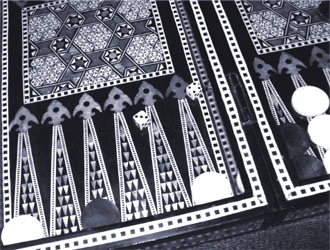|
| Magriel's NYT Columns |
 The Los Angeles Spring Classics Backgammon Tournament, sponsored by the American Backgammon Championships, was held last weekend at the Pacifica Hotel in Culver City, Calif.
The Los Angeles Spring Classics Backgammon Tournament, sponsored by the American Backgammon Championships, was held last weekend at the Pacifica Hotel in Culver City, Calif.
Elliot Winslow took first place in a field of 200 by defeating Todd Van der Plum. Gaby Horowitz overcame Alan Martin to win the consolation. In the intermediate section, Bill Franoff was the victor, and David Hershleder triumphed in the beginner’s group.
The diagrammed position shows how one player (Black) was deprived of a well-deserved victory by an unfortunate sequence of rolls. With White trapped securely behind Black’s six-point prime, Black felt confident. To win, Black had only to march his last man home and then bear off safely.
|
| Black to play 4-1. |
Black remained calm and was determined to make the best of his precarious situation. His first concern was how best to break his prime. The obvious choices where 7/6, 7/3, breaking the bar-point (7-point), or 8/7, 8/4, giving up the 8-point.
|
|
|
The correct play is 6/2*/1, giving up the 6-point in order to hit White and make the 1-point. By seizing the initiative and attacking first, Black greatly reduces White’s chances of hitting. In fact, White will reenter and hit less than one half of the time (16 chances out of 36). Giving up the 6-point is an unusual procedure, but Black must hit White and gamble to keep him off-balance for the next key roll.
In the actual game, Black was not rewarded for his valiant attempt to salvage the game. White next rolled a crushing 6-6 and played bar/6*, 12/18*, 17/23(2). White never redoubled, but went on to win a gammon.
Rollout
 Tom Keith 2013 |
|
Money play White owns 2-cube Black rolls 4-1 1296 games with VR Checker play: 2-ply Cube play: 3-ply Red |
| 4-1: | Game | G | BG | Equity | ||||
| 1 | 6/2*/1 |
W L |
.5511 .4489 |
.2327 .1517 |
.0031 .0041 | +0.0825 |

| (c) |
| 2 | 7/2* |
W L |
.4881 .5119 |
.2451 .2857 |
.0045 .0264 | −0.1780 | (0.2605) | |
| 3 | 8/7, 8/4 |
W L |
.3836 .6164 |
.0996 .0798 |
.0040 .0027 | −0.4375 | (0.5200) | (b) |
| 4 | 7/6, 7/3 |
W L |
.3522 .6478 |
.1176 .0948 |
.0053 .0041 | −0.4906 | (0.5731) | (a) |

|
|

